We are excited to announce that Issue 2 of RAMBLE is now live! This issue features poetry, prose, and photographs by Georgia Tech students of diverse cultural and academic backgrounds. Our authors write of the infiniteness of nature and of human smallness; of the comforts of mother tongues and grandmothers’ food; of the beauty of multilingualism but also of the at-times fraught relationship between language and identity, and of systemic issues of language and power. We hope that you enjoy their work as much as we do. If you’d like to learn more about RAMBLE, you can read about us here and check out Issue 1 as well.
Category: Uncategorized
“Polygluttony” at Duolingo’s Language Buffet
Introduction
When my mother-in-law comes to visit, once a day she pulls her phone out and says something like, “Time for Spanish!” Using the Duolingo app, she has been learning and practicing Spanish for some time. She has even built up a couple of impressive consecutive-days streaks numbering in the hundreds (meaning consecutive days meeting her specific daily language goals on Duolingo). When I acquired a smartphone, I too downloaded the Duolingo app because I wanted to begin studying German again. I received a minor in German in 2010 when I graduated with my B.A., but it has been a long while since I studied the language in a structured way.
I wanted to test out my first impression of Duolingo (the one I formed unfairly, of course before ever trying it out) as a language learning buffet by taking lessons in each of the languages it offers. This article is a reflection on my perceptions of the Duolingo app and my user-experience, as well as an evaluation of Duolingo’s functionality as a tool for language learning. Each day for just over a month I downloaded a different course and tried it out, journaling my impressions along the way. With some, I already had a level of proficiency, so I took the diagnostic test to see where Duolingo thought I was. With others, I knew absolutely nothing, so I started from square zero, also known as the “New to __________?” button. I am not seeking fluency in any of these languages because frankly I see that as an impossible goal to achieve in Duolingo anyway, even if I were to focus solely on a single course. It was more of a fun way to experience what it is like to be “Hgf” (username) on my Duolingo leader board, who has downloaded the Italian, Russian, Portuguese, Chinese, Spanish, and French courses. I am simply doing what that learner has done and taking it to an extreme.
Note: The slides embedded throughout this article are an account of my experiment taking lessons in a different language every day for just over a month. If you just read the journal, the slides will auto-advance. If you finish reading a slide before it advances, use the controls in the taskbar at the bottom of the frame to skip ahead.
Background
Using Duolingo, language learners, like my mother-in-law, can select any of a range of “standard,” endangered, or even constructed languages to study:
| Spanish
French German Italian English Japanese Chinese Russian Korean Portuguese Dutch |
Swedish
Norwegian Turkish Polish Irish Greek Hebrew Danish Hindi Czech Esperanto |
Ukrainian
Welsh Vietnamese Hungarian Swahili Romanian Indonesian Hawaiian Navajo Klingon High Valyrian |
According to its website, Duolingo collects data from language learners to discover how they learn language best. The Duolingo team claims, “With more than 300 million learners, Duolingo has the world’s largest collection of language-learning data at its fingertips. This allows us to build unique systems and uncover new insights about the nature of language and learning” (“Research”). Duolingo makes multiple publications about their approach to second-language learning on their website, as well as a favorable study conducted by researchers from the University of South Carolina and the City University of New York.
Every large-scale language-learning program requires a theoretical framework. The Duolingo system reflects at least in part the ideas of Stephen Krashen, whose input hypothesis, despite having received some criticism, has influenced many language learning programs in the U.S. today. To scaffold language-learning, Duolingo provides linguistic input in “the Four Skills”: reading, writing, speaking, and listening. Comprehensible input is language input around the learner’s proficiency level but involves what Krashen calls “i + 1” (Ellis 47). The phrase i + 1 refers to input that introduces new linguistic principles that students are primed to receive. I like to think of i + 1 in terms of Goldilocks and the Three Bears.
- “This porridge is too hot!” = i + 2-∞, meaning input that is so far beyond the learner’s proficiency level that it is essentially incomprehensible.
- “This porridge is too cold!” = i (or i + 0, if you prefer), meaning input consisting only of what a learner already knows. These principles might be good to practice, but they also might become boring, and without the introduction of new material might lead to stagnation.
- “This porridge is just right!” = i + 1, meaning comprehensible input or input that merges new content with enough known content that students can progress in the target language. Comprehensible input in the right kind of environment leads to language acquisition and the production of comprehensible output (output in the target language that makes sense to others) (Krashen 409).
The app approximates a learner’s proficiency level or i at the beginning of each course by providing a diagnostic test. If the learner already has some proficiency of which they are aware, they can click the button marked “Already Know Some __________? Try this Placement Test.” If not, the learner can click the “New to __________?” button and begin learning some basic vocabulary with the help of cues such as capital letters or even images. Those basic terms become keys to help students decipher input in the target language.
Trying the App
In my first lesson in Welsh, of which I previously knew nothing, I was presented with Bore da as my first sample of Welsh. I also received a number of multiple-choice answers to select from. Two of the possible answers were names: “Megan” and “Morgan”; two of them were capitalized: “Good” and “Goodbye”; and two of them were not capitalized: “good” and “morning.” Logically, I eliminate “Megan” and “Morgan” right off the bat (nothing personal), mainly because of their lack of lexical usefulness. Why would I need to know their names in Welsh? The target phrase was capitalized, so I kept “Good” and “Goodbye” and discarded “good” because the capital letter makes “Good” seems more likely than “good.” Bore da is also two words, so I decide on a two-word answer in English: “Good morning.” Choosing a two-word translation in the L1 for a two-word phrase in the target language is one instance of linguistic transfer, a common strategy employed by language learners to fill in gaps in their communicative competence. In this case, I have chosen correctly, even though I still do not know which Welsh word is “Good” and which is “morning.” Also, for all I knew, “Goodbye” in Welsh is also two words.
The lesson later asks me the meaning of da and provides multiple choices that include “good,” but not “morning.” I know that had I not received the capitalization cues in that first sample, I probably would have leaned on the syntax of my L1 and answered incorrectly because Bore da would be literally translated as “morning good” in English. Scaffolding cues like capitalization or images can matter greatly in helping beginning students puzzle out their first few steps into another language. Any program needs to know where a student’s proficiency level is before it can meet them where they are and guide them beyond it. In language learning, that is the true value of i.
Skepticism
As a brand-new Duolingo user, I had a hard time appreciating the app as a serious tool for language learning, despite its theoretical basis in SLA theory. I perceived it as more like a buffet for language learners in which we can choose one thing or choose some of all of our favorites. We can pile our plates with Polish and Chinese and Spanish and Hawaiian and High Valyrian, if they suit us. We aspiring polyglots (or maybe “polygluttons” is a more applicable term) can cram ourselves with little bits of a lot of different things, which is perfect if we are not interested in acquiring fluency but rather knowing more about individual languages and learning a few words and key phrases in each.
Language Journal
Conclusions
As a result of my exploration of the app, my impression of Duolingo as a language buffet remains unchanged. However, I do appreciate what it is trying to do with the technological affordances it has available. The system is impressive in the way it turns language learning into a game using rewards, fake currency, leader boards to promote competition, and leagues. It promotes engagement and provides learners with structure. It gives plenty of input, fortifies grammatical and lexical knowledge, and provides plenty of opportunities to practice reading and writing, though not nearly as much as it could listening and speaking. Overall, Duolingo is certainly making good on its endeavor to make learning engaging (“Our mission is to make learning free and fun,” says the app).
The game aspect provides plenty of extrinsic motivation for learners who need an additional push to study. Learners might lean toward either extrinsic (I want to learn a language because it is cool!) or intrinsic (“I want to learn a language because it will do something for me or promises a reward!”), but most learners need both to learn a language. I want to learn languages because I am interested in languages, but there were days when I had far less of a desire to study. However, I did not want to fall into the “Demotion Zone” (which is the bottom five on my leader board) because then I would fall into a lower league. I am currently in the Sapphire League, thank you very much, and I am not going back to the Gold League. That leader board gave me the push I needed to study.
That being said, there are a number of people using the app who find the game aspect unsustainably fulfilling. After a while, the motivation derived from that part of the game can ebb away. Another aspect that Duolingo learners complain about is that some people are in it more for the game than the language, and so search for shortcuts to make more points or “XP,” as the game calls them. When the student’s focus turns away from language learning toward a secondary feature, the app becomes less successful at what it ought to be doing.
All things considered, I am not buying Duolingo’s other claim about its mission, namely, “To develop the best education in the world and make it universally available” (“Crown Levels: A Royal Redesign”). I believe they want this, and based on the number of people using the app, I would say that they are certainly reaching toward the “universal availability” objective. But it doesn’t offer the “best education” yet, and it likely never will unless we come up with a quantifiable standard to define what it means to be “best.” Like any other language program, Duolingo has limitations. No one should download and use the Duolingo app without first understanding that it is not THE WAY to learn a language because there is no such thing, as Dr. Brent Wolter pointed out in a 2019 interview (“TESOL”). That being said, Duolingo provides opportunities for prospective learners to increase their communicative competence in a target language within a low-stakes and gamified environment that can motivate learners who are motivated either intrinsically or extrinsically.
Using Duolingo as the sole source of one’s language learning will only set a learner up for disappointment if they think they can use it to achieve native-like proficiency in the “Four Skills.” Duolingo is probably best used as a language learning supplement that activates your brain during your early commute on the train as you puzzle out the difference between the Turkish words adam and erkek or the Portuguese words copo and xicara. Prospective users of this app would be well served if they would keep, as I do, a dictionary and a good grammar book about the target language on hand, and find friends to consult and converse with in that language as well.
Note: As a final note to educators, I can say that trying out the Duolingo app could be a useful experience. If you want a quick way to learn a little bit about the languages your students speak without having to commit yourself to a full-blown language course, Duolingo might be the way to go. My Georgia Tech students come from many different countries and speak languages I do not know, including Chinese, Turkish, Tamil, etc. Having tried to learn a little bit of some of those languages and felt the frustration that comes from attempting to learn a language so dissimilar from my L1, I feel greater empathy for their endeavors to learn English. In fact, any opportunity teachers or tutors can get to know the first languages of those they teach a bit better, the better off those teachers will be. I believe language, linguistics, and ESL teachers would be well-served to find some language-learning program (if not Duolingo, then something else that might be affordable and effective, if not “free and fun”). They can try out some of the lessons and see if it influences their linguistic awareness, as well as their attitudes toward the English learners in their classes.
Addendum: Since this article, Duolingo has made a few updates, one of which is especially noteworthy. In the summer of 2019, Duolingo released an Arabic for English speakers course. I made a note of the absence of such a course in my journal entry on Swahili, finding it strange that such a significant language would not be represented in the app. Duolingo has also continued to develop other language courses, including Finnish, Scottish Gaelic, and Yiddish.
Works Cited
Duolingo. “Research.” Duolingo, n.d., https://ai.duolingo.com/. Accessed 25 Mar. 2019.
Ellis, Rod. Second Language Acquisition. Oxford University Press, 1997.
Krashen, Stephen. “The Input Hypothesis: An Update.” Georgetown University Round Table on Languages and Linguistics (GURT) 1991: Linguistics and Language Pedagogy: The State of the Art. Georgetown University Press, 1992. Google Books, https://books.google.com/books?id=GzgWsZDlVo0C&printsec=frontcover&source=gbs_ge_summary_r&cad=0#v=onepage&q&f=false. Accessed 27 Mar. 2019.
Rollinson, Joseph. “Crown Levels: A Royal Redesign.” Duolingo, 11 July 2018, https://making.duolingo.com/crown-levels-a-royal-redesign.
Wolter, Brent. “Dr. Brent Wolter on Teaching English to Speakers of Other Languages (TESOL).” World Englishes, Georgia Institute of Technology, 13 Mar. 2019, https://worldenglishes.lmc.gatech.edu/interview-dr-brent-wolter-on-tesol/. Accessed 27 April 2019.
This article appeared on our site in 2019 and is now being republished here as part of a website makeover. ~ Jeff Howard
“Infinite Jest and Sesquipadalia: Reading for (Scrabble) Vocabulary”
I recently finished reading David Foster Wallace’s book Infinite Jest (1996), and I am exhausted. It seemed that every page I read on average contained some word I could not define, even using context clues. Ryan Compton estimates that “Wallace used a vocabulary of 20,584 words to write Infinite Jest.” This vast vocabulary contains jargon, archaisms, neologisms, and all-around sesquipedalia—long, polysyllabic words—that almost no one uses in daily conversations. Visualizing situations in which you might need to use some of these words itself is a chore for the imagination, unless you too are planning to write a mind-melting maximalist novel or simply want to add more ammunition to your Scrabble arsenal. “That’s cachexia for 284 points, dude!”
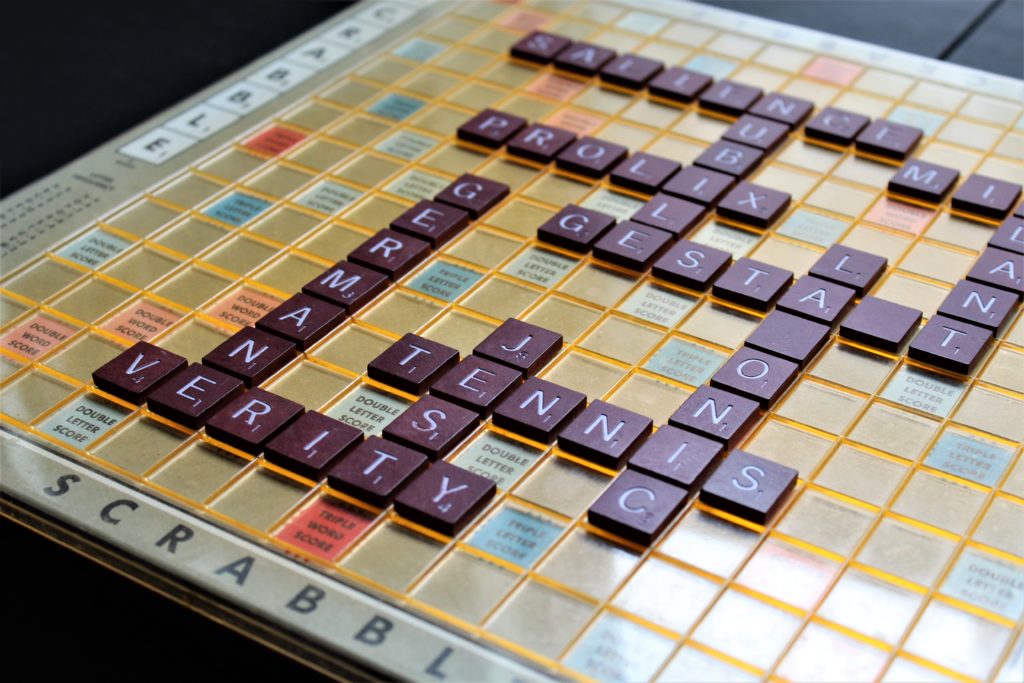
All language learners face the challenge of developing their vocabulary to achieve fluency. It is one thing to know where certain types of words ought to go in a sentence (syntax), but it is another to find the exact words to plug into a sentence in a conversation or other form of communication. Learners often know what they want to say in another language, but they may not know the exact word to help them say it in the target language. A lack of vocabulary often leads to a reliance on circumlocution, or using words we do know to describe the thing or concept we do not know, either as a conversational strategy or a coping mechanism.
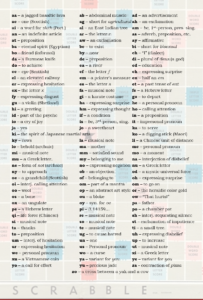 Reading is a great way to increase vocabulary. Reading alone is not going to make anyone fluent in all four skill areas (reading, writing, listening, and speaking), but it can provide a rich source of comprehensible input. (Much of Infinite Jest does not even begin to approach what Stephen Krashen would call “i + 12,” let alone “i + 1.”) When learners encounter unknown words in books, articles, or other publications, they can use any number of strategies to bring that word into their personal lexicon.
Reading is a great way to increase vocabulary. Reading alone is not going to make anyone fluent in all four skill areas (reading, writing, listening, and speaking), but it can provide a rich source of comprehensible input. (Much of Infinite Jest does not even begin to approach what Stephen Krashen would call “i + 12,” let alone “i + 1.”) When learners encounter unknown words in books, articles, or other publications, they can use any number of strategies to bring that word into their personal lexicon.
-
-
- Look up the word in a dictionary and read the definition out loud
- Use the immediate context in the passage to make sense of the word
- Write down the word in a notebook as part of a vocabulary list and drill yourself on the word and its meaning
- Use the word in other sentences, either written or spoken, and in other situations or contexts
-
Even individuals who have spoken a language for many years encounter words they do not recognize from time to time. According to a BBC article, a typical “native speaker” only knows about 15,000–20,000 word families, but English contains many more word families or “lemmas” than that. No one can be a master of all domains of linguistic usage, so someone like me with an advanced degree in English will constantly run across new words through reading different types of material. That does not mean we should shoot to hang around the average. Knowing more words than we need to use in our daily personal and professional lives can enrich our worldviews and help us make connections and associations that lead us down new avenues of thought. In short, it makes us well-rounded, broader-minded people.
In this article, I had originally intended to provide my own new vocabulary list—which is something I used to do in my university German courses—based on my own reading of Infinite Jest. The list would consist of words like Kekuléan and presbyopic and espadrilles, as well as numerous drug-related terms. However, I am still compiling that list and may be at it for the foreseeable future. Numerous other people have already compiled their own online Infinite Jest word lists, though, so I am providing links to those resources. Feel free to use them to sate your curiosity, increase your own vocabulary, or at the very least–if you’re at all like me–pad your Scrabble scores.
“Over 200 Words Collected from Infinite Jest” (Rob Hoffman)
“Infinite Jest Vocabulary” (Ben Zimmer)
“What David Foster Wallace Circled in His Dictionary” (Slate)
“Words from Infinite Jest” (Grant Barrett)
“Infinite Jest: David Foster Wallace”
“Words David Foster Wallace Circled in His Dictionary That Were Used in Infinite Jest (And Where They Appear)” (DFW Words)
This post was previously published on our site in 2020 and is appearing here as part of website makeover. ~ Jeff Howard
Language, Communication, Microdocs: Great Big Story
While traipsing across the internet last week, I stumbled upon an addictive little YouTube channel called Great Big Story. Forgive me, I might be late to this party, but if you’ve never heard of it, up until five months ago, Great Big Story was, as their About page on YouTube puts it, “a global media company devoted to cinematic storytelling.”
The micro-documentaries produced by Great Big Story are informative, intriguing, and just plain brilliant, and the channel has such a range of topics that you are bound to find something you love. Some of my favorites include “Enter the Deadliest Garden in the World,” “Why Sweden Loves Food in Tubes,” and “Why the World’s Mathematicians Are Hoarding Chalk.” I am currently considering the possibility of having my composition students make micro-documentaries for my class in the fall; this channel would be a wonderful resource for readings and examples of the genre.
Because we are inherently interested in language, communication, and culture here on this site, I wanted to provide a list of potential episodes that are interesting and relevant to our mission, interests, and target audiences. Happy watching!
Recommendations
“This Man Speaks 32 Languages”
“Saving the World’s Oldest Languages”
“Saving Languages from Extinction”
“This Turkish Language Isn’t Spoken, It’s Whistled”
“Everyone in This Village Can Speak Sign Language”
“How the Language From the Sims Was Created”
“Saving an Ancient Language Through Pop Music”
“The Chocolate Croissant Controversy”
“Talking Fast With a Record-Setting Speed Talker”
“This Man Can Pronounce Every Word in the Dictionary”
“Play on Words: Meet Nigeria’s Scrabble King”
“The Surprising Science Behind the Word ‘Pokémon’”
“Meet the Epic Voice Behind Movie Trailers”
“This Dialect Coach Can Transport You With Her Perfect Accents”
“Giving Artists With Disabilities a Space to Thrive”
“The Artist Paints What She Hears”
“A Photographer’s Mission to Capture a New Image of Africa”
“The Largest Handwritten Family Tree in the World”
World Cinema Spotlight: 3 Idiots
Review: Alok Amatya
Rajkumari Hirani’s 3 Idiots (2009) is a Bollywood masala film in which the lead characters make their way through one of the prestigious colleges of the Indian Institutes of Technology (IIT). The film is unique in spotlighting mental health issues facing students at institutions of higher learning, even as it includes the usual trappings of buddy films, college humor, and romantic comedy. One of the major characters in the film (Raju) attempts suicide when he’s at the brink of being expelled from college, but eventually recovers. What makes the flick very relatable for a global audience is its candid discussion of the pressures weighing on college students. 3 Idiots did very well commercially in Southeast Asian markets, in addition to being a big hit in India. A very entertaining watch overall, the film stars notable Indian actors, such as Aamir Khan, Kareena Kapoor, and R. Madhavan.
Likes
At the heart of the film is a struggle between the romantic individual spirit (embodied in the everyday college student) and the mammoth of the modern educational system. Students like Raju and Farhan are trapped in a system that wants them to mechanistically master the art of acing written examinations, until they can be freshly minted as graduates. As with many students around the world, these characters’ dreams of upward social mobility are pinned to obtaining the prestigious college degree. As you watch the film, you want the characters to make it out with their spirit intact, without being crushed by the system. I like the idea that global audiences can relate with the film’s characters based on their own experiences with a similar system, cutting across several cultural differences. Parts of the film are shot in the scenic areas of Ladakh (including Pangong Lake) that are now administered by India’s union government.
Dislikes
Hirani’s films are prone to cringeworthy moments of misogyny, xenophobia, and homophobia. In 3 Idiots, the butt of the main characters’ jokes is a Uganda-born student of Indian origin (Chatur), who is presented as a deserving target for pranks because of his bad Hindi. While several of the pranks on Chatur come across as bullying, the cringe elements all come together in a scene where his speech in front of a college assembly is sabotaged by the film’s protagonist (Rancho). Chatur is a Hindi learner who often goes beyond his vocabulary by reading from a script (or consulting a dictionary), cuing Rancho to replace the words in his speech with unsavory jokes about sexual molestation. The film is adapted from Chetan Bhagat’s novel Five Point Someone (2004), which is thoroughly disliked by literary critics for its over-the-top drama and pandering to the audience. Bhagat has written a slew of novels about IIT that have been adapted into films since the success of 3 Idiots.
Review: Jeff Howard
Perhaps I am biased because I love Aamir Khan’s work. I love Lagaan (2001), Taare Zameen Par (2007), Talaash (2012), and Dangal (2016), but watching Khan goof all over the set of 3 Idiots was such a joy for me. This film. Was. AWESOME! While Alok certainly has a point about the cringe elements of the film potentially crossing a line, it is also difficult not to appreciate the point being made through the character Chatur and his humiliation. The approval Chatur had received from university administrators and professors drives home the idea, though not seamlessly, that what the modern institution of higher learning seems to value is not free-thinking or trail-blazing, but instead regurgitated facts encased in jargon that create an effigy of knowledge rather than the real thing. In that way, the characterization of Chatur reminds me of T.S. Eliot’s line in Choruses from the Rock, “Where is the knowledge we have lost in information?”
If you like, you can think of 3 Idiots as being very much in the same vein as Dead Poets Society (1989), but with better singing and dancing and more laughs. (No disrespect to Robin Williams, of course.) Such a comparison does betray that cinematically, yes, indeed, we’ve trod this ground before, but nevertheless 3 Idiots remains a super fun/funny and sometimes emotional film despite its flaws, as well as an important one for people like Alok, me, and our colleagues who teach at a STEM school. 3 Idiots is on Amazon Prime, but luckily you can also find it on YouTube. A big thanks to the two students who recommended the film to me in the first place.
As a bonus for our fellow writing and communication teachers out there, I just want to share one of my favorite clips from 3 Idiots. Find a way to use this clip in any presentation that involves science communication, pitching your work to the public, jargon/disciplinary language, grant writing, and academic writing, etc. Trust me. It will make your point, and it will leave an impression.
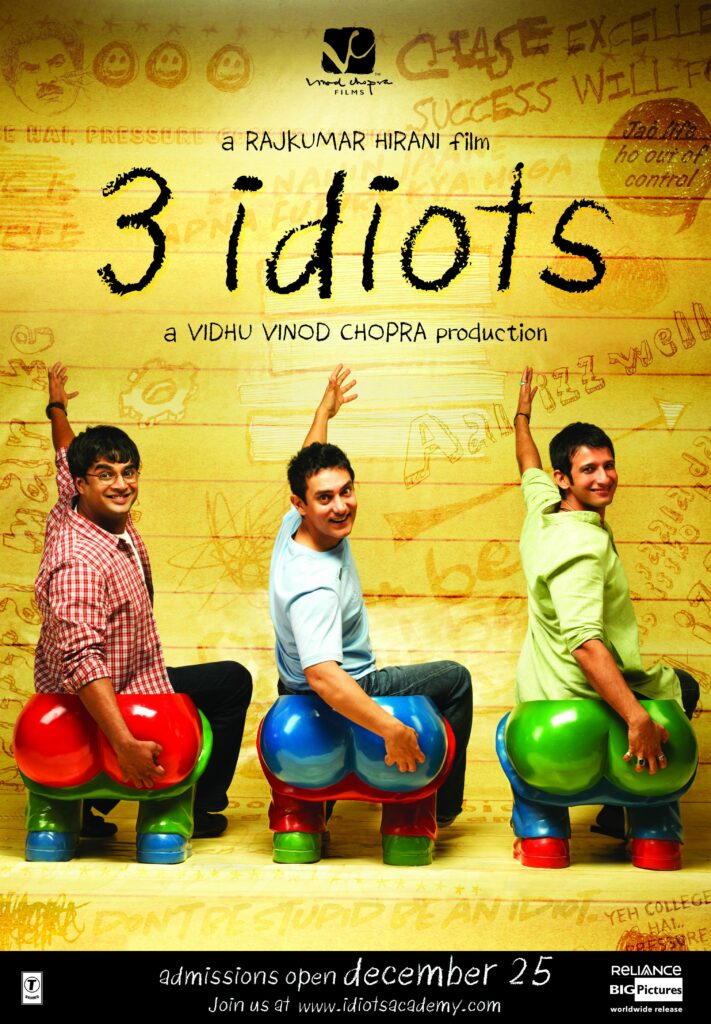
Title: 3 Idiots
Director: Rajkumar Hirani
Released: 2009
Country: India
Language: Hindi and English
English Subtitles: Y
Closed Captioning: Y
Streaming/Available on: Amazon Prime and YouTube
Works Cited
“3 Idiots.” IMDb, n.d. https://www.imdb.com/title/tt1187043/. Poster.
“3 Idiots | OFFICIAL trailer #1 US/indian (2009).” YouTube, uploaded by moviemaniacsDE, June 6, 2010, https://www.youtube.com/watch?v=K0eDlFX9GMc.
Eliot, T.S. “Opening Stanza from Choruses of the Rock.” Westminster, n.d., http://www4.westminster.edu/staff/brennie/wisdoms/eliot1.htm. Accessed 06 Mar. 2021.
The World Englishes Committee Welcomes Film Scholar Anu Thapa
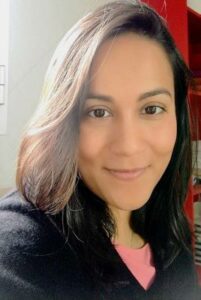 The World Englishes Committee is pleased to announce that Anu Thapa, a film scholar and first-year Marion L. Brittain Fellow in the Writing and Communication Program, has recently joined our ranks. Anu’s specialties include Cinema and Media Studies, Digital Humanities, and Postcolonial Theory. She is currently spearheading the committee’s forthcoming initiatives related to global cinema (more information to come). We are excited to have her expertise and look forward to working with her .
The World Englishes Committee is pleased to announce that Anu Thapa, a film scholar and first-year Marion L. Brittain Fellow in the Writing and Communication Program, has recently joined our ranks. Anu’s specialties include Cinema and Media Studies, Digital Humanities, and Postcolonial Theory. She is currently spearheading the committee’s forthcoming initiatives related to global cinema (more information to come). We are excited to have her expertise and look forward to working with her .
As we have done in the past, we asked Anu a few questions (as we do with all of our new committee members) to help us get to know Anu better. We also asked her to fill out the Pivot questionnaire, and you can find her answers to that here, along with those of our other committee members.
Why did you want to be part of this committee?
I wholeheartedly subscribe to what Chimamanda Adichie calls the “danger of a single story.” (This TED talk is worth watching!) I would extend it further to the danger of a single way to tell/write/visualize stories. As a film scholar, I think about and work on the plurality of cinemas and cinema languages. World Englishes, which thinks about the heterogeneity of the English language, perfectly fits my academic and non-academic pursuits.
What do you like best about teaching?
I teach film, so we watch a lot of films in my courses. I like showing my students bizarre and foreign films. Getting their reactions during class discussions and seeing how their attempts to make sense of these films progresses by the end of the semester is a really humbling and rewarding experience. Equally humbling are moments when they detest a film you love.
If there weren’t a pandemic and you had a bit of free time, how would you choose to spend it?
Going to the movies!
What is the best movie you’ve seen in the last year?
Steve McQueen’s Lover’s Rock. Absolutely gorgeous and sensual. It is also the only film I have seen during the pandemic that hasn’t given me anxiety over watching an enclosed space packed with bodies touching, writhing, and breathing at each other. This pandemic has definitely changed how I watch and experience movies.
What is the book you want to read most but haven’t had a chance to read yet?
Tough to only name one, as it is an occupational hazard to collect books you want to read but haven’t had a chance to read. This meme sums me up in this context:
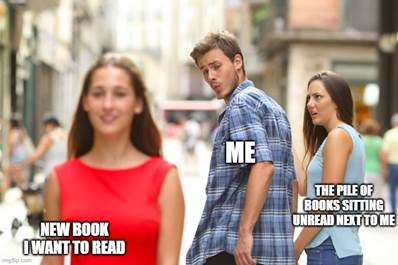
Translation and Literary Magazines
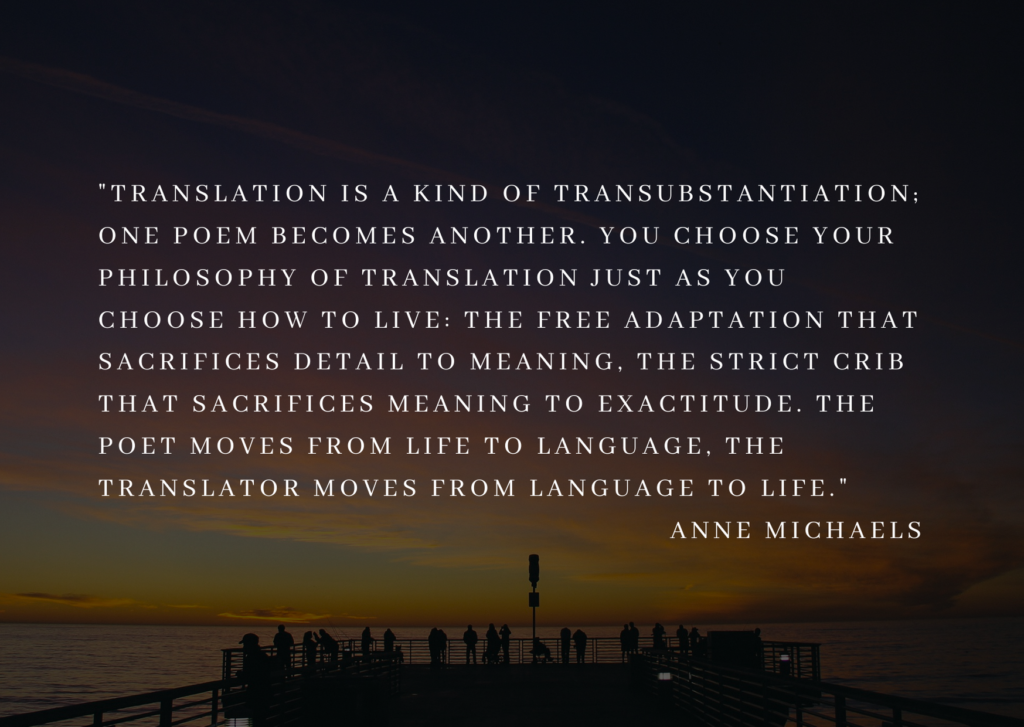 As a creative writer and literary magazine editor, I love reading brand-new work in brand-new, hot-off-the-press issues of my favorite literary magazines. They come in the mail, in orange bubble mailers, having never even been opened. The spine stiff with freshly congealed glue pops and cracks as I turn the pages. I hold it near my face and breathe in. Mmmm.
As a creative writer and literary magazine editor, I love reading brand-new work in brand-new, hot-off-the-press issues of my favorite literary magazines. They come in the mail, in orange bubble mailers, having never even been opened. The spine stiff with freshly congealed glue pops and cracks as I turn the pages. I hold it near my face and breathe in. Mmmm.
While there are innumerable contemporary literary magazines publishing online and in print, including several at Georgia Tech, such as Erato, Terminus, Atlanta Review, and of course RAMBLE, I would like to focus this post on literary magazines that are engaging with the important work of literary translation. As a junior in college, I was first introduced to the world of contemporary literary translation by a professor, Steven Stewart, who was translating works by Spanish-speaking writers such as Rafael Pérez Estrada, Ana María Shua, and Eduardo Milán. As a result, I, too, was compelled to engage with literary translation and even published a translation of a poem by Emilio de Marchi in my university’s student-run literary magazine during my senior year.
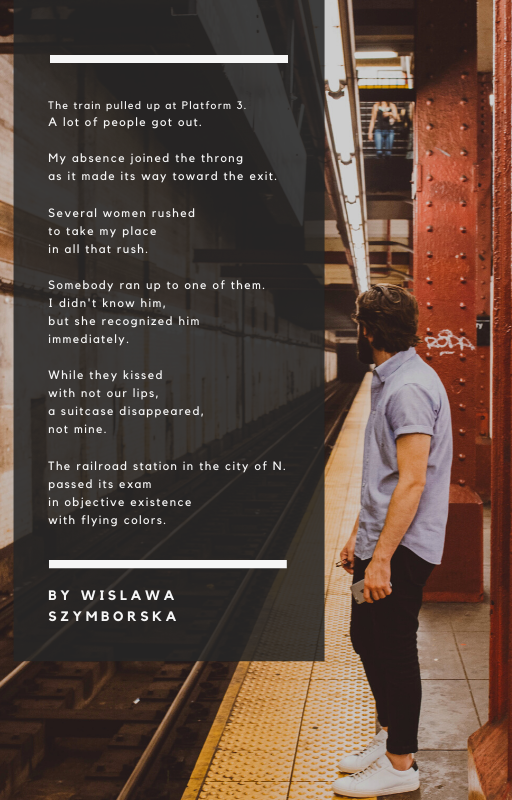 During my first semester teaching at Georgia Tech, I sat on a MARTA platform waiting for my train, reading a collection of poems by Wislawa Szymborska. As I was about to pass through the train doors and find my seat, a man approached me and, noticing the book in my hands, commented in a Polish accent how brilliant Szymborska was. I replied, smiling, that I thought so too, and then we each located our seats in different parts of the train car. This encounter encapsulates the kinds of intersections that literary translation promotes, not just between readers and texts, but among people of many nationalities, cultures, languages, and experiences. Literary translation allows poets and audiences to meet who otherwise might never have crossed paths. It removes linguistic barriers that impede access to new ideas and new situations. Without translation, the man on the train and I would likely never have spoken, brief though our encounter was, and though I would never have known it, I believe I would have been poorer as a result of that missed connection.
During my first semester teaching at Georgia Tech, I sat on a MARTA platform waiting for my train, reading a collection of poems by Wislawa Szymborska. As I was about to pass through the train doors and find my seat, a man approached me and, noticing the book in my hands, commented in a Polish accent how brilliant Szymborska was. I replied, smiling, that I thought so too, and then we each located our seats in different parts of the train car. This encounter encapsulates the kinds of intersections that literary translation promotes, not just between readers and texts, but among people of many nationalities, cultures, languages, and experiences. Literary translation allows poets and audiences to meet who otherwise might never have crossed paths. It removes linguistic barriers that impede access to new ideas and new situations. Without translation, the man on the train and I would likely never have spoken, brief though our encounter was, and though I would never have known it, I believe I would have been poorer as a result of that missed connection.
As a former member of the American Literary Translators Association (ALTA), I feel that literary translation plays an important role in making literature accessible to international and transnational audiences. Poetry@Tech, an organization at Georgia Tech whose “mission is to bring high-profile and celebrated poets, as well as new and exciting voices, to Atlanta, and to share the art of poetry with Georgia Tech students and the communities across Georgia,” is currently engaged in this kind of valuable cultural work. For instance, as part of the Atlanta Poetry and Translation Festival, in October 2020 Poetry@Tech held a reading involving a number of poets from Germany, and in March 2021 will host a group of poets from Belarus.
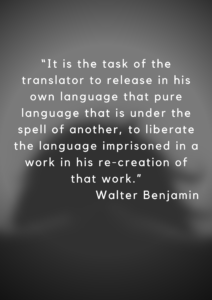 Here is a brief list of just a few contemporary magazines who are also using their publication platform as a means to promote translated works by writers all over the world, as well as their own descriptions of their mission as it relates to literary translation.
Here is a brief list of just a few contemporary magazines who are also using their publication platform as a means to promote translated works by writers all over the world, as well as their own descriptions of their mission as it relates to literary translation.
“Alchemy is committed to publishing quality, contemporary translations of poetry, fiction, and non-fiction creative writing. By dedicating our journal to the publication of high quality translations by students and emerging translators, we aim to encourage a new generation of translators. We publish creative translations and adaptations, including homophonic, homolinguistic, and other poetic forms. It is our belief that translation can teach us new things about writing and about language itself. We look forward to publishing work that is fresh, engaging, and thought provoking. Alchemy is based in the University of California, San Diego’s Literature and Linguistics departments and is edited and published by UCSD students.”
“Winner of the 2015 London Book Fair’s International Literary Translation Initiative Award, Asymptote is the premier site for world literature in translation. We take our name from the dotted line on a graph that a mathematical function may tend toward, but never reach. Similarly, a translated text may never fully replicate the effect of the original; it is its own creative act.
“Our mission is simple: to unlock the literary treasures of the world. (Watch a video introduction of Asymptote here.) To date, our magazine has featured work from 121 countries and 103 languages, all never-before-published poetry, fiction, nonfiction, drama, and interviews by writers and translators such as J. M. Coetzee, Patrick Modiano, Herta Müller, Can Xue, Junot Díaz, Ismail Kadare, David Mitchell, Anne Carson, Haruki Murakami, Lydia Davis, Ann Goldstein, and Deborah Smith.”
“CAGIBI is invested in sharing the universal human experiences to be found in works of prose and poetry set within places unfamiliar to readers; thus, our expressed interest in international—or world—literature, and works in translation. CAGIBI is versatile in its purpose and mission to readers and writers. The journal concerns literature in which character conflict, ultimately story, is tied to place. The retreats provide unique and stimulating place experience. In one interpretation, le cagibi is the place at which a writer’s inspiration is rendered into story, or shaped into poem.”
“Circumference is a journal whose mission is to support poetry in translation; primarily translations of new work from around the globe, new visions of classical poems, translations of foreign language poets of the past who have fallen under the radar of American readers, and pieces that illuminate translation as a vibrant, necessary interaction. Through our website we facilitate conversations about international literature and translation in real-time, and promote dialogues that enliven our sense of what it means to bring new work into English.”
“An Online Journal of Translation, is a forum for poetry and translation. We hope to stimulate the under-explored arts of reading in other tongues and translating for an English audience. We aim both for new knowledge of world writers and for the creation of beautiful new works. Ezra is interested in any form, style, tone or era.
“We dedicate ourselves to the spirited interplay of cultures, and to the presence of the laurel itself in the act of literary translation: to the transformative, promethean, synthesizing essence of poetry.
“Ezra hopes to have more writers live and work in the space between cultural and linguistic constructs — just as poetry lives in betweenness.
“Beyond the love of languages — their sounds and separate geniuses — we are alert to the occasional translation that is (as Márquez said of Rabassa) better than the original. We dedicate ourselves to the successes — mysterious and many — that await literary translators.”
“Metamorphoses is the journal of the Five College Faculty Seminar on Literary Translation. Published in the spring and fall, the journal provides a forum for literary translation out of, and into, all languages, and for papers on the theory and practice of literary translation.”
To find other magazines looking for and publishing literary work in translation, click here.
“Apologies for Cross-posting”: CFPs in the Digital Humanities
Introduction
After combing through the DHSI listserv, that steady pipeline of hidden gems for academic projects, we found more than a few CFPs and announcements, several of which overlap with the topics and issues with which the editors of this website are interested in. Here are a smattering of these opportunities:
CFP for “Right to Left” at DHSI 2021—Online Edition
We are soliciting papers related to digital work in any living or historical RTL language such as Arabic, Azeri, Hebrew, Kurdish, Ottoman, Persian, Syriac or Urdu. Possible topics might include RTL languages and cultures seen from any of these angles:
- bidi/multidirectionality
- digital culture in RTL societies
- open social scholarship
- digital pedagogy
- integrating RTL into global digital humanities
- platforms and user experience
- transliteration practices (e.g., Arabizi, P/Finglish)
- internationalization/localization (e.g., interface translation)
- adapting and building digital resources and methods (e.g., RTL XML)
Please send 200-word abstracts and participant bios to rtlright2left@gmail.com by February 25, 2021.
Accepted participants will prepare a pre-recorded short talk (10 mins) which will be posted in advance of the conference on a password-protected site available to conference registrants. During the conference there will be a two-hour live discussion of accepted papers.
A publication of papers from this year’s conference is anticipated along with previous two years in the open access journal Interdisciplinary Digital Engagement in Arts & Humanities (IDEAH).
The ADE Program Committee solicits presentations for panels and individual papers on recovery broadly, including efforts of small-scale projects; rare or marginal texts; texts and artifacts produced by women, Indigenous people, Black people, People of Color and other marginalized groups; texts that dislodge the single author model; the exploration of the ways in which scholarly editions, archives, and pedagogical recovery projects can avoid reproducing colonization/marginalization; the ways in which editors can offer context to historically famous figures to avoid placing them on a pedestal; and the role that new technologies, social media environments, editorial institutes, and community groups play in advancing these objectives. We welcome projects and individuals in all disciplines and at any stage of their career, as well as those who engage in public history and advancing knowledge beyond the academy.
Please submit inquiries and 300-word abstracts and brief bio(s) to Noelle Baker (noelle.baker@me.com) by 1 March 2021.
Potential topics include but are not limited to:
- Initiatives to support peer review of and recovery work by marginalized figures
- Editing and minimal computing in the Global South
- Community recovery work
- Teaching with recovered materials in K-12 classrooms
- Digital technologies, accessibility, and the broadening/democratizing of knowledge
- Recovering hidden voices and stories through their interactions with canonical figures
- Editors’ responsibility to engage with emerging scholarship adjacent to their figures
- Decolonializing archives, records, and editions (including but not restricted to metadata, bibliographies, and indexing) for the discoverability of marginalized and underrepresented groups
- Challenges and strategies in placing historic (and imperfect) figures in context in 2021
- Editorial institutes and expansive definition(s) of what constitutes digital recovery
- Editorial treatment of understudied documents for which encoding is scholarship
- Pedagogical experiments with micro editions and recovery
- Teaching an imperfect past in 2021
- Decolonialized approaches to recovery
- Social editions, new platforms, and more democratic models of recovery
- Creating discoverability for underrepresented individuals via county/state sheriffs’ records, professional licensing records, store ledgers, and other related records
NEH is Hiring! Program Specialist in the Division of Preservation and Access:
Full Information: https://www.usajobs.gov/GetJob/ViewDetails/589725600
Open & closing dates: 01/19/2021 to 02/09/2021
The National Endowment for the Humanities is an independent grant-making agency of the government dedicated to supporting research, education, preservation, and public programs in the humanities. The Division of Preservation and Access provides leadership and support for a sustained national effort to preserve and increase the availability of resources important for research, education, and public programming in the humanities.
The Program Specialist assists with administrative activities that support managers and program officers in the Division of Preservation and Access. The duties of this position are focused on supporting the review of complex grant applications administered by the Division, including making analytical decisions and recommendations on actions as may be appropriate as to assure accurate administrative control for compliance with applicable Division and Endowment regulations, procedures, and policies as well as:
- Participates in grant program management through monitoring workflows, distributing materials for outreach, and review of proposals.
- Provides guidance to applicants on inquiries regarding specific grant programs within the division.
- Participates in the administration of application review by conducting statistical analyses of application and awards.
- Writing humanities content for public audiences.
Qualifications
Professional experience working in a cultural heritage organization, university, or with grants
A Bachelor’s degree in a discipline of the humanities is required (a Master’s degree in the humanities, library & information science, museums studies, or a related field is preferred).
Conditions of Employment: U.S. Citizen; Relevant experience and/or education; Favorable background investigation; Males born after 12/31/1959 must be registered with the Selective Service
Grade: GS 11
Salary: $72,750 to $94,581 per year
Appointment type: Permanent
Work schedule: Full-Time
“I’m especially interested in bringing a more global and multicultural range of subject matter to our review pages. This means that while our general focus on the social and cultural influence of information remains unchanged, I am eager to seek out books and reviewers with origins and expertise in areas beyond the Anglosphere and Global North.
Do you have a book coming out that fits with the editorial mission of Information & Culture?
Is there a new or upcoming book that you would like to review?
If so, please contact reviews@ischool.utexas.edu to let us know!
We are also currently seeking reviewers for the following titles:
A History of Data Visualization and Graphic Communication
Michael Friendly, Howard Wainer; June 2021
https://www.hup.harvard.edu/catalog.php?isbn=9780674975231
Burning the Books: A History of the Deliberate Destruction of Knowledge
Richard Ovenden; November 2020
https://www.hup.harvard.edu/catalog.php?isbn=9780674241206
Please get in touch via reviews@ischool.utexas.edu if you are interested in reviewing these or other titles.
More information: Information & Culture is an academic journal printed three times a year by the University of Texas Press. It publishes original, high-quality, peer reviewed articles examining the social and cultural influences and impact of information and its associated technologies, broadly construed, on all areas of human endeavor. In keeping with the spirit of information studies, we seek papers emphasizing a human-centered focus that address the role of and reciprocal relationship of information and culture, regardless of time and place.
The journal welcomes submissions from an array of relevant theoretical and methodological approaches, including but not limited to historical, sociological, psychological, political and educational research that address the interaction of information and culture.”
Classroom Icebreakers: What Saturday Night Live Has Taught Us about Communication
Teachers frequently use interesting, exciting, and hilarious media clips as icebreakers to grab students’ attention and introduce them to classroom topics. Over the years, Saturday Night Live has produced a number of sketches connected to the subject of communication. Sometimes the sketches speak explicitly about specific communication strategies or genres, while at other times they provide a fun example of what not to do if you want to be an effective communicator. This post contains links to just a few SNL sketches that Writing and Communication instructors can use as icebreakers in their courses.
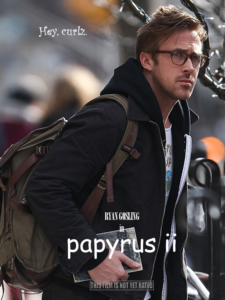 Graphic Design
Graphic Design
“Papyrus”: In this intense parody trailer, Ryan Gosling plays a man haunted by one designer’s font choice when he created the logo for James Cameron’s 2009 film Avatar.
Ethics
“Plagiarism”: A high school teacher (played by Chris Parnell) confronts his cheating students (played by Seth Meyers, Ashton Kutcher, Rachel Dratch, and Amy Poehler), teaching them about the pitfalls of plagiarizing.
Instructional Technology
“PowerPoint”: Mikey Day and Idris Elba team up as Microsoft tech experts running a PowerPoint workshop. Hilarity and anxiety ensue as some of the people in the workshop struggle to create a set of simple slides. A few of these same cast members/characters later come together for another hysterical sketch called “Zoom Call,” in which they parody many of the behaviors that have become commonplace–and even cliché–in teleconferencing.
Bonus clip: “Kate McKinnon Improvises a PowerPoint Presentation”: Though not technically a Saturday Night Live clip, SNL cast member Kate McKinnon rises to the challenge of doing a business presentation, using slides she has never seen before.
Essays
“Dorm Room Posters”: One college student (Pete Davidson) is struggling to write his history paper. The posters in his dorm room come to life in order to give him advice on how to write an academic paper, but only most of them are helpful.
Letters
“The War in Words: William and Lydia”: Mikey Day and Phoebe Waller-Bridge parody the documentary genre as communication breaks down in this amusing exchange of letters between a WWII soldier and his wife. Day also does a similar sketch as a WWI soldier writing to his wife (played by Claire Foy) with similar communication mishaps.

Social Media
“Barbie Instagram”: Three Mattel interns (Pete Davidson, Donald Glover, and Heidi Gardner) are tasked with brainstorming captions for Instagram posts featuring Barbie. SNL would later do a similar sketch called “Ken Instagram” featuring Rachel Brosnahan.
“Why’d You Post That?”: Kevin Hart stars in new game show in which he yells at contestants for their inept use of social media.
Public Speaking
“Down by the River”: A classic sketch involving Chris Farley as motivational speaker Matt Foley, whose awkward presentation convinces two teenagers to change their lives.
Literature
“Substitute Teacher”: A substitute teacher (played by Lin-Manuel Miranda) relies on Hollywood tropes and pop culture to try to inspire a skeptical AP English class to love literature. Years earlier, in 1996, the SNL cast had done a “Substitute Teacher” sketch called “Suel Forrester: Substitute Teacher,” in which nearly everyone in a classroom of high school students (Will Ferrell, Cheri Oteri, Molly Shannon, and others) have no idea what their substitute teacher (played by Chris Kattan) is trying to tell them. Teachers, please, slow down and annunciate.
Poetry
“Poetry Class with Drake”: Over the years, SNL has done many sketches involving teachers and students. “Poetry Class” is actually a sequence of sketches involving a poet named Ms. Meadows (played by Vanessa Bayer), who tries to teach high school students about why poetry is cool. Cameron Diaz and Miley Cyrus also appear in “Poetry Class” sketches.
Oral Communication
Intonation is a powerful indicator of meaning. In this sketch, “Sarcasm 101,” Matthew Perry essentially teaches an entire class about using tone to to say one thing and mean another.
Upcoming Online Events about Diversity
taken from the University of Victoria listserv: institute@lists.uvic.ca
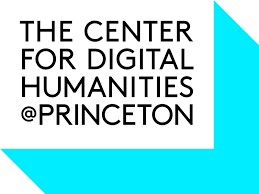
Do you wish you could do large-scale text analysis on the languages you study? Is the lack of good linguistic data and tools a barrier to your research?
The Center for Digital Humanities at Princeton is calling for applications for New Languages for NLP: Building Linguistic Diversity in the Digital Humanities, a 3-part workshop series to be held between May 2021 and August 2022. Deadline for applications is January 10, 2021.
We are seeking a cohort of scholars working with diverse languages that currently lack NLP resources. No technical experience is necessary to participate. Institute participants will learn how to annotate linguistic data and train statistical language models using cutting-edge NLP tools and will advance their own research projects.
For more information and to apply, see our project website: https://newnlp.princeton.edu/application/
This Institute workshops is funded by a National Endowment for Humanities Institutes for Advanced Topics in the Digital Humanities grant, and is a collaboration between the Princeton CDH, Haverford College, the Library of Congress Labs, and DARIAH.
Please feel free to contact the project directors with questions:
Natalia Ermolaev (nataliae@princeton.edu)
Andrew Janco (ajanco@haverford.edu)
taken from https://diversity.gatech.edu/mlk-celebration

Join us virtually for the 10th annual
Martin Luther King Jr. Lecture
featuring Nikole Hannah-Jones
January 14 at 3:30 p.m.
Hannah-Jones is the creator of the New York Times Magazine’s “The 1619 Project,” about the history and lasting legacy of American slavery, for which her powerful introductory essay was awarded the Pulitzer Prize for commentary. She has also won a Peabody Award, two George Polk Awards, and is a three-time winner of the National Magazine Awards.
The commemoration of the life and work of Martin Luther King Jr. at the Georgia Institute of Technology encompasses an ambitious slate of events organized by faculty, staff, and students. Our 2021 MLK celebrations will include various virtual and in-person educational programs and service opportunities to encourage active participation from the campus and nearby community.
As an academic institution dedicated to advancing a culture of inclusive excellence, we reflect upon the contributions of Martin Luther King Jr. during our annual celebration. We recognize the ongoing global struggle for social justice, social courage, and the need for sustainable social change. We are pleased to honor King’s legacy as we set the agenda for the next civil rights movement.
To view the listing of 2021 MLK celebration events, visit here.
